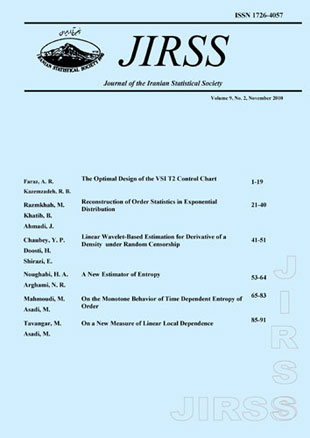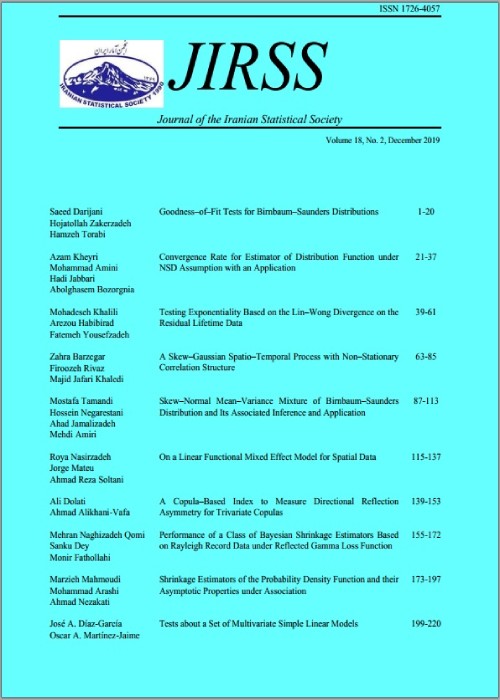فهرست مطالب

Journal of Iranian Statistical Society
Volume:12 Issue: 2, 2013
- تاریخ انتشار: 1392/08/18
- تعداد عناوین: 7
-
-
Pages 193-210A simple step-stress accelerated life testing plan is considered when the failure times in each level of stress are geometrically distributed under Type-I censoring. The problem of choosing the optimal plan is investigated using the asymptotic variance-optimality as well as determinant-optimality and probability-optimality criteria. To illustrate the results of the paper, an example is presented and a sensitivity analysis is performed. A simulation study is also done to investigate the robustness of the criteria with respect to estimation error of the parameters. Eventually, some conclusions are presented.Keywords: Asymptotic variance, optimality, determinant, optimality, Fisher information, order statistics, probability, optimality
-
Pages 211-234In this paper we consider some four-parametric, so-called Generalized Pareto-like Frequency Distribution, which have been constructed using stochastic Birth-Death Process in order to model phenomena arising in Bioinformatics (Astola and Danielian, 2007). As examples, two”real data” sets on the number of proteins and number of residues for analyzing such distribution are given. The conditions of coincidence of solution for the system of Likelihood Equations with the Maximum Likelihood Estimators (MLE) for the parameters of this distribution are also investigated. In addition, we propose Accumulation Method as a recurrence method for approximate computation of the MLE of the parameters. Simulation studies are done.Keywords: Accumulation method, birth, death process, generalized Pareto, like frequency distribution, Kolmogorov, Smirnov (K, W) test, Markov chain monte carlo (MCMC), MLE.
-
Pages 235-252Maximum likelihood (ML) estimation based on bivariate record data is considered as the general inference problem. Assume that the process of observing k records is repeated m times, independently. The asymptotic properties including consistency and asymptotic normality of the Maximum Likelihood (ML) estimates of parameters of the underlying distribution is then established, when m is large enough. The bivariate normal distribution is considered as an highly applicable example in order to estimate the parameter θ = (μ1, σ1, μ2, σ2) by ML method of estimation based on mk bivariate record data. Asymptotic variances of the ML estimators are calculated by deriving the Fisher information matrix about θ contained in the vector of the first k bivariate record data. As another application, we concerned the problem of “breaking boards” of Glick (1978, Amer. Math. Monthly, 85, 2-26) by considering three different sampling schemes of breaking boards and we computed the relative asymptotic efficiencies of ML estimators based on these three types of data.Keywords: Additivity, bivariate distribution, Fisher information matrix, inverse sampling, Jensen's inequality
-
Pages 253-270In this paper, we propose to study a generalized form of the exponential power distribution which contains others in the literature as special cases. This unifying exponential power distribution is characterized by a parameter ω and a function h(ω) which regulates the tail behavior of the distribution, thus making it more flexible and suitable for modeling than the usual normal distribution, while retaining symmetry. We derive several mathematical and statistical properties of this distribution and estimate the parameters using both the moments and maximum likelihood approach, obtaining the information matrix in the process. The multivariate extension of the distribution is also examined. Finally we fit the univariate generalized exponential power distribution as well as the normal distribution to data on eggs produced by chicken on each of two different poultry feeds (inorganic and organic copper-salt compositions) and show that the generalized exponential power distribution fit is considerably better. We then use the Kolmogorov-Smirnov two samples one-tailed test to show that there is an increase in egg weights and decrease in cholesterol level when the feed is organic.Keywords: Exponential power distribution, information matrix, inorganic copper, salt, maximum likelihood estimation, multivariate exponential power distribution, organic copper, salt, poultry feeds data
-
Pages 271-292In this paper, a family of skew-slash distributions is defined and investigated. We define the new family by the scale mixture of a skew-elliptically distributed random variable with the power of a uniform random variable. This family of distributions contains slash-elliptical and skew-slash distributions. We obtain the moments and some distributional properties of the new family of distributions. In the special case of slash skew-t distribution, an EM-type algorithm is presented to estimate the parameters. Some applications are provided for illustrations.Keywords: Heavy tailed distributions, scale mixture distributions, skew, elliptical distributions, slash distribution
-
Pages 293-320Wind as a resource of renewable energy has obtained an important share of the energy market already. Therefore simulation and prediction of wind speeds is essential for both, for engineers and energy traders. In this paper we analyze the surface wind speed data from three prototypic locations: coastal region (Rotterdam), undulating forest landscape few 100 m above sea level(Kassel), and alpine mountains about 3000 m above sea level (Zugspitze). Rather than matching the conventional Weibull distribution to the wind speed data, we investigate two alternative models for wind speed prediction, both being refinements of a log-normal model, but with very different approaches and capability for capturing the extremal events. In both models deterministic effects such as trend and seasonality are separated. The first (structural stochastic) model predicts wind speeds exponentially from a linear combination of separate mean-reverting jump processes for the high and low wind speed regimes, and the regular (diffusive) wind speed regime. The second (neuro-stochastic) model is a prediction with volatility-enhanced trend, with parameters dynamically learned by the middle-layer neurons of an MLP-type neural network operating on dynamically updated and re-weighted history. The numerical results suggest that, for a coastal region (e.g. Rotterdam) the R2-determination is higher, while for the undulating forest regions (e.g. Kassel) and even more the higher mountain regions (e.g. Zugspitze) the structural stochastic model yields higher determination. The neuro-stochastic algorithm opens a new path within statistical learning: feature space and kernel functions are completely defined by the parameters of the stochastic process.Keywords: Alternative energy, jump, diffusion processes, neural network, Weibul distribution.
-
Pages 321-334This study introduces a new approach to problem of estimating parameter(s) of a given copula. More precisely, using the concept of the generalized linear models (GLM) accompanied with least square method, we introduce an estimation method, say GLM-method. A simulation study has been conducted to provide a omparison among the inversion of Kendal’s tau, the inversion of Spearman’s rho, the PML, the Copula-quantile regression with (q = 0:25; 0:50; 0:75), and the LMmethod. Such simulation study shows that the GLM-method is an appropriate method whenever the data distributed according to an elliptical distribution.Keywords: Copula, copula, quantile regression, GLM, parameter estimation


